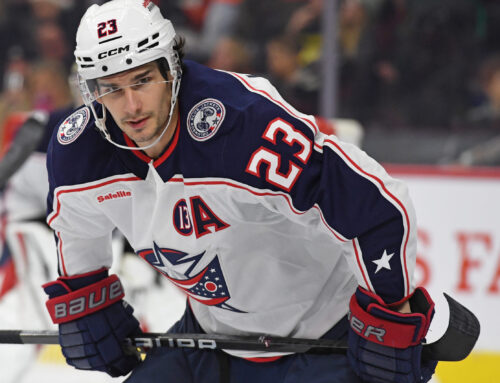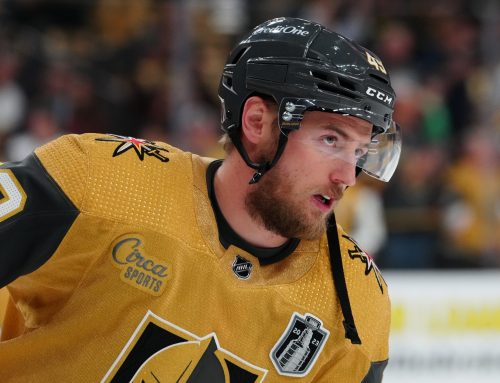We have finally hit that mid-season break moment where some of the NHL's best players go hang out for a few days and compete for glorious prizes. This mark at the season tends to be viewed as sort of the unofficial and not actually halfway point of the season so I wanted to take a moment and dig into the numbers a bit and see what we find.
I was particularly interested in looking at goal and point paces before and after the All-Star break. In order to get a look at this, I picked past season data where the league was operating in a more usual fashion at the time. The years in question are 2018-19 and 2019-20. I didn't include 20-21 as it was a pretty usual season, but kept 19-20 as the majority of the impacts were limited to the final games. That being said it does mean the sample size for the second half of 19-20 is a bit smaller. This actually gets to one point I wanted to bring up on the outset. The All-Star game is typically held at the end of January (January 25th and 26th in the years in question). That means even in the best-case scenario we are comparing a 50ish game sample to a 30ish game sample. In the case of 19-20 it is closer to a 50-game sample to a 20-game sample. Suffice it to say it is an imperfect way to cut a season and yet it is a bit of a natural breaking point and we tend to give it significance.
For process steps here I went and pulled Big Board reports for specific time periods. I was looking at two seasons, roughly split in half, so I used the Custom Date Range option to run a report for the beginning of the season to the break, and then from the break to the end of the season. I exported those reports, grabbed the columns I needed and did some fancy filtering to get the data below.
A couple of interesting stats right off the bat. Over the two seasons the average points per game rate in the first half of the season was .412 and the average goal per game rate was .155. Over the second half of the season the average point per game rate dropped to .394 and the average goal rate dropped to .145. That means your completely average player would lose .018 points per game over the second half and .01 goals per game. Now clearly those specific numbers are not that helpful for a given player as we are talking changes that amount to maybe half point over the course of 30 games. But they are illustrative of the point that generally players score a little bit less in the second half of the season.
One other point to make here is that first half scoring is not nearly as predictive, or correlated to second half scoring as I would have assumed. Now hang on because we are going to get statsy for just a second. We can use a formula to tell how closely related two data sets are. In this case we are going to use r^2. Basically, the closer to one the output is the more alike the two data sets are. Generally speaking, .25 is a weak correlation, .5 is somewhat correlated, and over .75 is a strong correlation. When looking at points per game the correlation number is .55 and for goals per game is .425. For me at least that suggests that knowing a players first half pace isn't really that helpful when trying to predict their second half. It is somewhat related, but a lot more goes into it than that (which is of course what all of the fantasy articles are all about).
Okay enough preamble. On to the data.
The following table contains the top point paces in the first half of 2019-20 and then compares them to after the All-Star Game:
| Prior To ASG | Post ASG | |||||||||
| Name | Pos | GP | PTS/GP | G/P | GP | PTS/GP | G/P | Δ PTS/G | Δ G/G | |
| 2019-20 | CONNOR MCDAVID | C | 49 | 1.55 | 0.55 | 15 | 1.4 | 0.47 | -0.15 | -0.08 |
| 2019-20 | LEON DRAISAITL | C | 49 | 1.53 | 0.55 | 22 | 1.59 | 0.73 | 0.06 | 0.18 |
| 2019-20 | NATHAN MACKINNON | C | 49 | 1.47 | 0.61 | 20 | 1.05 | 0.25 | -0.42 | -0.36 |
| 2019-20 | DAVID PASTRNAK | R | 51 | 1.37 | 0.73 | 19 | 1.32 | 0.58 | -0.05 | -0.15 |
| 2019-20 | ARTEMI PANARIN | L | 47 | 1.45 | 0.55 | 22 | 1.23 | 0.27 | -0.22 | -0.28 |
In 2019 we see something that isn't too surprising. Most of the top point paces from the first half did not continue in the second half. Not that all of them fell off dramatically (and some – looking at you, Leon Draisaitl) maintained or improved on their paces. Of the top 50-point paces in 2019, about one-third of them saw decreased paces in the second half.
And then the same table for 2018-19:
| Prior To ASG | Post ASG | |||||||||
| Name | Pos | GP | PTS/GP | G/P | GP | PTS/GP | G/P | Δ PTS/G | Δ G/G | |
| 2018-19 | NIKITA KUCHEROV | R | 49 | 1.59 | 0.45 | 33 | 1.52 | 0.58 | -0.07 | 0.13 |
| 2018-19 | MIKKO RANTANEN | C | 50 | 1.48 | 0.46 | 24 | 0.54 | 0.33 | -0.94 | -0.13 |
| 2018-19 | JOHNNY GAUDREAU | L | 51 | 1.43 | 0.57 | 31 | 0.84 | 0.23 | -0.59 | -0.34 |
| 2018-19 | CONNOR MCDAVID | C | 49 | 1.49 | 0.59 | 29 | 1.48 | 0.41 | -0.01 | -0.18 |
| 2018-19 | PATRICK KANE | R | 50 | 1.42 | 0.58 | 31 | 1.26 | 0.48 | -0.16 | -0.10 |
None of the top five paces saw an increase in the second half. He appears off screen, but Draisaitl again makes an appearance as the top player in 2018-19 who did. He is still much in the minority, though, as other than him we have the exact same percentage of top 50 players performing better during the second half. 16 in fact, or about a third.
Switching gears for a second, let's specifically look at goals per game before and after the All-Star Break.
| Prior To ASG | Post ASG | |||||||||
| Name | Pos | GP | PTS/GP | G/P | GP | PTS/GP | G/P | Δ PTS/G | Δ G/G | |
| 2019-20 | DAVID PASTRNAK | R | 51 | 1.37 | 0.73 | 19 | 1.32 | 0.58 | -0.05 | -0.15 |
| 2019-20 | AUSTON MATTHEWS | C | 49 | 1.16 | 0.69 | 21 | 1.1 | 0.62 | -0.06 | -0.07 |
| 2019-20 | ALEX OVECHKIN | L | 49 | 1.02 | 0.69 | 19 | 0.89 | 0.74 | -0.13 | 0.04 |
| 2019-20 | NATHAN MACKINNON | C | 49 | 1.47 | 0.61 | 20 | 1.05 | 0.25 | -0.42 | -0.36 |
| 2019-20 | JACK EICHEL | C | 48 | 1.29 | 0.58 | 20 | 0.8 | 0.40 | -0.49 | -0.18 |
It is the exact same story with goals per game. 16 of the top 50 goal paces saw increases from first to second half. Alex Ovechkin essentially maintained his pace and then after him, you guessed it, Draisaitl with the 10th highest goal pace to start the season (.55), finished strong with a .73 goals per game pace.
| Prior To ASG | Post ASG | |||||||||
| Name | Pos | GP | PTS/GP | G/P | GP | PTS/GP | G/P | Δ PTS/G | Δ G/G | |
| 2018-19 | ALEX OVECHKIN | L | 50 | 1.14 | 0.74 | 31 | 1.03 | 0.45 | -0.11 | -0.29 |
| 2018-19 | VIKTOR ARVIDSSON | R | 28 | 0.93 | 0.68 | 30 | 0.73 | 0.50 | -0.2 | -0.18 |
| 2018-19 | JEFF SKINNER | L | 48 | 0.92 | 0.63 | 34 | 0.56 | 0.29 | -0.36 | -0.33 |
| 2018-19 | BRAYDEN POINT | C | 49 | 1.33 | 0.61 | 30 | 0.9 | 0.37 | -0.43 | -0.25 |
| 2018-19 | JOHN TAVARES | C | 49 | 1.1 | 0.61 | 33 | 1.03 | 0.52 | -0.07 | -0.10 |
In 2018-19 it is the same story, only a bit worse. All of the top scoring players saw decreases in their scoring pace and only seven of the top 50 were able to increase their scoring. The top ranked pace to show an increase in the second half? Draisaitl. He started the season at .54 points per game and ended at .72.
Clearly Draisaitl is onto something here. On average, he paced for 112 points over the first half of these two seasons and then increased to a 122-point pace for the second half. That has to be excellent news for his managers this season who are hoping he can continue his 123-point pace from the first half of 21-22.
What of the rest? Well, here are the top 10-point paces through the All-Star Break.
| Name | Pos | GP | PTS/GP | G/G |
| NIKITA KUCHEROV | R | 11 | 1.55 | 0.455 |
| LEON DRAISAITL | C | 42 | 1.5 | 0.762 |
| CONNOR MCDAVID | C | 41 | 1.46 | 0.561 |
| NAZEM KADRI | C | 41 | 1.46 | 0.463 |
| NATHAN MACKINNON | C | 31 | 1.39 | 0.290 |
| JONATHAN HUBERDEAU | L | 47 | 1.36 | 0.362 |
| KIRILL KAPRIZOV | L | 40 | 1.33 | 0.475 |
| BRYAN RUST | R | 24 | 1.33 | 0.583 |
| MIKKO RANTANEN | C | 41 | 1.32 | 0.585 |
| AUSTON MATTHEWS | C | 39 | 1.31 | 0.744 |
If recent trends hold, only three of them will improve their paces over the second half, and one of those three will be Draisaitl. That leaves two – any bets? The rest will fall off the pace at least somewhat.
What else can we learn from these splits? Are there other players who seem to be performing better after the All-Star break? Or Worse? All this and more next week on Frozen Tool Forensics.
That is all for this week
Do your part to support organizations working to make hockey for everyone.





 PHI
PHI TOR
TOR ANA
ANA NYI
NYI BUF
BUF CGY
CGY VAN
VAN CAR
CAR STL
STL MTL
MTL BOS
BOS
